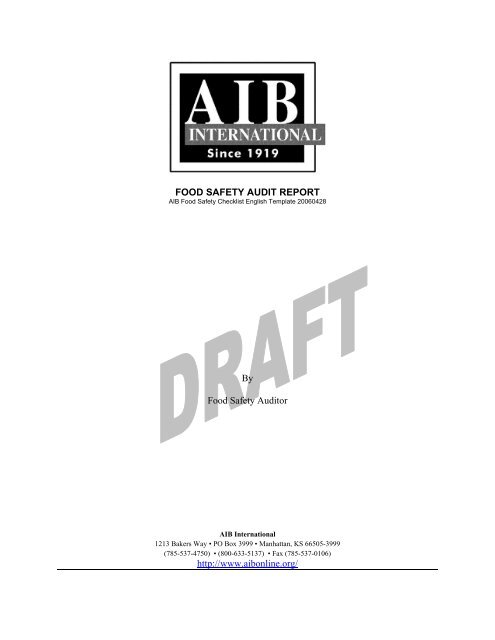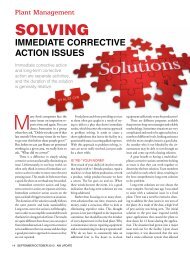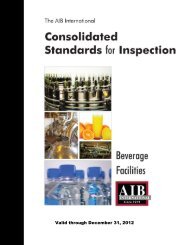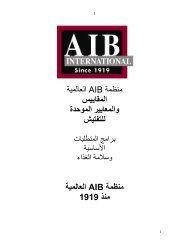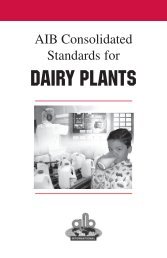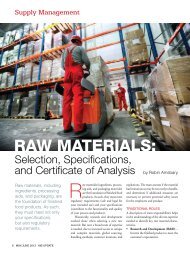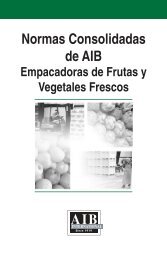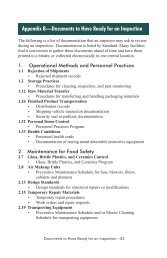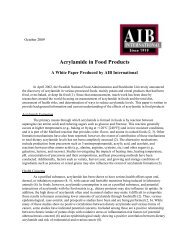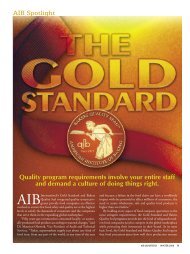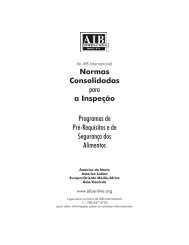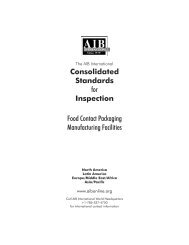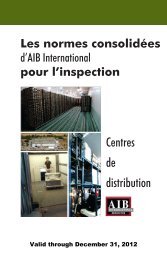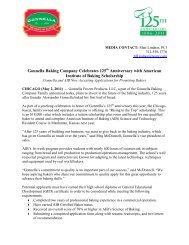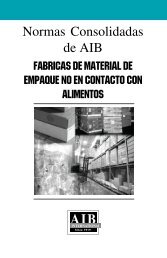FOOD SAFETY AUDIT REPORT By Food Safety Auditor http://www ...
FOOD SAFETY AUDIT REPORT By Food Safety Auditor http://www ...
FOOD SAFETY AUDIT REPORT By Food Safety Auditor http://www ...
You also want an ePaper? Increase the reach of your titles
YUMPU automatically turns print PDFs into web optimized ePapers that Google loves.
<strong>FOOD</strong> <strong>SAFETY</strong> <strong>AUDIT</strong> <strong>REPORT</strong><br />
AIB <strong>Food</strong> <strong>Safety</strong> Checklist English Template 20060428<br />
<strong>By</strong><br />
<strong>Food</strong> <strong>Safety</strong> <strong>Auditor</strong><br />
AIB International<br />
1213 Bakers Way • PO Box 3999 • Manhattan, KS 66505-3999<br />
(785-537-4750) • (800-633-5137) • Fax (785-537-0106)<br />
<strong>http</strong>://<strong>www</strong>.aibonline.org/
RATING<br />
A food safety audit was conducted at this facility on Error! Reference<br />
source not found.. The writer was accompanied throughout the audit by Mr.<br />
(<strong>AUDIT</strong>OR FILL IN).<br />
Excellent cooperation was received by the writer, and on some occasions,<br />
the items were immediately corrected.<br />
At the conclusion of the audit, a meeting was held to discuss the<br />
observations, recommendations, and rating.<br />
Based on the observations made, the information obtained, and the criteria<br />
set forth in the AIB Consolidated Standards for <strong>Food</strong> <strong>Safety</strong>, the overall food<br />
safety level of this facility was considered to be:<br />
UNSATISFACTORY<br />
(0)<br />
An “Unsatisfactory” rating was assigned due to (<strong>AUDIT</strong>OR FILL IN<br />
WHEN APPLICABLE)<br />
The “serious” or “unsatisfactory” items are shaded, boxed, and<br />
bolded in the text of the report. Refer to the definitions in the AIB<br />
Consolidated Standards.<br />
The “improvement needed” items are designated in bold type and<br />
require prompt attention.<br />
The AIB International states that the report as given herein is to be<br />
construed as its findings and recommendations as of the date of this report. The<br />
AIB International accepts no responsibility and does not assume any<br />
responsibility for the food safety program in effect with (customer). That further<br />
AIB International is only making report of the food safety conditions of<br />
(customer) as of the date of this report and assumes no responsibility or liability<br />
as to whether (customer) carries out the recommendations as contained in this<br />
report or does not carry out the recommendations as contained in this report.<br />
p.1
RATING ANALYSIS<br />
DATE OF <strong>AUDIT</strong>: Error! Reference source not found.<br />
TYPE OF <strong>AUDIT</strong>: Error! Reference source not found.<br />
OVERALL RATING: UNSATISFACTORY<br />
ADEQUACY OF <strong>FOOD</strong> <strong>SAFETY</strong> PROGRAM<br />
PEST CONTROL<br />
OPERATIONAL METHODS AND PERSONNEL PRACTICES<br />
MAINTENANCE FOR <strong>FOOD</strong> <strong>SAFETY</strong><br />
CLEANING PRACTICES<br />
TOTAL: 0<br />
p.2
AIB <strong>FOOD</strong> <strong>SAFETY</strong> CHECKLIST – FOR <strong>FOOD</strong> <strong>SAFETY</strong><br />
OK = None or minor discrepancy S = Serious IN = Improvement Needed U = Unsatisfactory created 12/02<br />
Adequacy of <strong>Food</strong> <strong>Safety</strong> Program OK IN S U Comments<br />
1. Responsibility and authority for ensuring compliance with federal,<br />
state, governmental and/or any other appropriate regulatory law or<br />
guideline had been clearly assigned to a competent supervisory<br />
level person(s), and a functional organizational chart was<br />
maintained. The competent supervisory level person ensured that<br />
all employees were aware of their responsibilities and mechanisms<br />
were in place to monitor the effectiveness of the operation and had<br />
obtained the required regulatory food security registration.<br />
Quality Manual<br />
2. The company had a system in place to ensure that it was kept<br />
informed of all relevant legislation; food safety issues; legislative,<br />
scientific, and technical developments; and industry codes of<br />
practice. This system was maintained at a central corporate level<br />
or at the plant level.<br />
3. The department(s) responsible for implementing<br />
hygiene/sanitation, quality control or quality assurance had<br />
established written procedures or work instructions outlining<br />
specific responsibilities of each department member and employee<br />
in a Quality Manual.<br />
4. These procedures and work instructions were defined in job<br />
descriptions, and appropriate arrangements were in place to cover<br />
for the absence of key employees.<br />
5. This Quality Manual stated the company’s commitment to quality<br />
and had a scope that covered and implemented the requirements in<br />
these standards.<br />
6. The Quality Manual was readily available to relevant staff, and the<br />
company’s management regularly reviewed its quality and<br />
production systems to ensure continued effectiveness and<br />
suitability.<br />
7. The Quality Manual included a clearly defined and documented<br />
quality policy statement that stated the company’s intention to<br />
meet its obligations to produce safe and legal products and its<br />
responsibility to its customers.<br />
8. The company’s senior management had demonstrated commitment<br />
to the implementation of the Company Quality Policy by signing<br />
off on this policy. All supervisory staff and key personnel<br />
understood and implemented the policy, and the policy had been<br />
communicated throughout the company and was regularly<br />
reviewed.<br />
This regulatory compliance responsibility had<br />
been assigned to<br />
The quality and production systems were last<br />
reviewed on<br />
The quality policy was signed by<br />
p.3
Adequacy of <strong>Food</strong> <strong>Safety</strong> Program (cont’d) OK IN S U Comments<br />
Self-Inspections<br />
9. The facility had established a formal food safety committee.<br />
This committee was multidisciplinary in membership and<br />
operated on a predetermined frequency ensuring that complete<br />
inspections of the entire facility were conducted no less than<br />
once per month. Records of each inspection were an integral<br />
part of this requirement, and documentation of specific<br />
assignments and actual accomplishments were maintained.<br />
Follow-up inspections were done to ensure that items were<br />
corrected.<br />
10. The company audited systems and procedures critical to product<br />
safety, legality, and quality, to ensure they were in place,<br />
appropriate, and complied with. The audits were scheduled and<br />
their scope and frequency were established in relation to the risks<br />
associated with the activities being audited.<br />
11. These internal systems and procedures audits were carried out by<br />
competent auditors who were independent of the area of<br />
operation being assessed. Results of the internal audit were<br />
brought to the attention of the personnel responsible for the<br />
activity audited.<br />
12. Corrective actions and timescales for their implementation were<br />
agreed upon. A record of all programmed internal audits and<br />
associated corrective actions was maintained. Corrective actions<br />
were verified to ensure satisfactory completion.<br />
Budget<br />
13. All departments directly involved in implementing food safety<br />
have established an appropriate budget and support to maintain<br />
the proper and timely acquisition of appropriate tools, materials,<br />
equipment, monitoring devices, chemicals, and pesticides.<br />
Cleaning Programs<br />
14. A Master Cleaning Schedule for periodic cleaning assignments<br />
and a daily housekeeping schedule had been undertaken as a<br />
formalized written plan. The MCS specifies frequency,<br />
responsibility, and postcleaning evaluation and was up to date.<br />
The schedule includes the outside grounds, building, drains,<br />
utensils, and equipment, including refrigeration equipment.<br />
The most recent monthly inspection was<br />
conducted on<br />
The schedule was up to date, and conditions in<br />
the facility supported the documentation.<br />
p.4
Adequacy of <strong>Food</strong> <strong>Safety</strong> Program (cont’d) OK IN S U Comments<br />
15. Detailed equipment cleaning procedures were developed for<br />
personnel training and maintaining the hygiene level of the<br />
equipment. These written procedures were developed and<br />
utilized for cleaning all equipment used for food storage,<br />
processing, and packaging and for all building areas and outside<br />
grounds.<br />
Documentation and inspection of incoming materials:<br />
16. Documented procedures for inspection of incoming raw<br />
materials were maintained.<br />
17. All incoming raw ingredients and packaging were inspected by<br />
trained personnel using proper and appropriate equipment.<br />
18. Records indicating date of receipt, carrier, lot number,<br />
temperature, amounts, and product condition were maintained.<br />
19. Bulk deliveries, both dry and liquid, include visual inspection<br />
both before and after unloading. These inspections were<br />
documented.<br />
20. Incoming vehicles were inspected to ensure product integrity.<br />
These inspections were documented.<br />
21. Raw materials susceptible to mycotoxins, pathogenic<br />
microorganisms, or autolysis from temperature abuse were<br />
segregated and covered by a separate written procedure.<br />
22. Appropriate specifications were on file for raw materials,<br />
packaging materials, finished products, and intermediate/<br />
semiprocessed products. The specifications were adequate and<br />
accurate to ensure compliance with relevant food safety and<br />
legislative requirements. Specifications were, where<br />
appropriate, formally agreed upon with relevant parties and<br />
reviewed periodically.<br />
23. Records of results of examinations and/or copies of supplier<br />
guarantees or certifications verifying compliance with federal or<br />
other governmental regulations, guidelines, or Defect Action<br />
Levels of raw materials, food packaging, and products were<br />
maintained.<br />
Hazard Analysis Critical Control Point (HACCP) program<br />
24. The HACCP program had a senior management commitment.<br />
This manager had signed the program.<br />
p.5
Adequacy of <strong>Food</strong> <strong>Safety</strong> Program (cont’d)<br />
25. A multidisciplinary team had been established with a team leader<br />
identified. The team leader had been trained and demonstrated<br />
competence in understanding and applying HACCP principles.<br />
HACCP team members had been trained and had adequate<br />
experience. At least one team member had certified HACCP<br />
training.<br />
OK IN S U Comments<br />
26 Prerequisite programs had been developed prior to the HACCP<br />
plan. These include cleaning and sanitation/hygiene, GMPs and<br />
personnel practices, pest control, preventive maintenance,<br />
chemical control, food safety customer complaints, recall and<br />
traceability, supplier specifications and control, and receiving,<br />
storage, and shipping.<br />
The HACCP program included the following points:<br />
27. Descriptions of each product manufactured and identified<br />
hazards inherent to the items manufactured.<br />
28. An assessment of risk had been completed and identified which<br />
hazards were of such nature that their elimination or reduction to<br />
acceptable levels was essential to the safe production of food.<br />
29. A hazard analysis study was undertaken for all products, new<br />
and old, to identify and assess all potential safety hazards and<br />
associated risks.<br />
30. The critical control points (CCPs) were identified and the<br />
procedure for controlling the hazard was well described. The<br />
CCPs identified were controlled and monitored within the<br />
predetermined limits described in the plan.<br />
31. The critical limits were identified. All critical limits were<br />
scientifically established and recorded.<br />
32. Specified monitoring frequency and designated person(s)<br />
Records were collected by<br />
responsible for testing.<br />
33. Establish and document deviation procedures.<br />
34. Establish and document verification procedures. The records were verified by<br />
35. Maintain documentation of procedures, records of conformance,<br />
and effective correction actions resulting from nonconformance.<br />
36. The processes and process lines were covered by the HACCP<br />
system and were reviewed on at least an annual basis. Records<br />
The annual review was conducted on<br />
of this review should be maintained for a minimum of two years.<br />
37. Management and employee training was conducted both in<br />
HACCP protocol and the associated program documentation.<br />
All employees working at a designated CCP area had basic<br />
training and experience.<br />
p.6
Adequacy of <strong>Food</strong> <strong>Safety</strong> Program (cont’d)<br />
Training<br />
OK IN S U Comments<br />
38. The Personnel Department had created specific, written<br />
procedures for providing food safety training to all personnel,<br />
including new employees, and maintained records of training<br />
completion. The training included written employee policies<br />
that have been established for the company.<br />
39. Refresher training was conducted on at least an annual basis for<br />
The last refresher training was held on<br />
all existing employees.<br />
40. Prior to beginning work, temporary personnel and contractors<br />
were trained as appropriate and were adequately supervised<br />
throughout the working period.<br />
41. A formalized, written program for evaluation of consumer<br />
complaints, particularly those related to adulteration, had been<br />
established. This program conformed to company policy and<br />
included the rapid dissemination of complaint information to all<br />
departments responsible for implementation of the food safety<br />
program. Complaint information was used, where appropriate,<br />
to avoid recurrence and implement ongoing improvements to<br />
product safety, legality, and quality. Actions appropriate to the<br />
seriousness and frequency of the problems identified appeared to<br />
be carried out promptly and effectively.<br />
42. A documented recall program was on file for all products<br />
manufactured. This procedure was regularly reviewed. All<br />
products were coded, and lot or batch number records were<br />
maintained. Distribution records were maintained to identify the<br />
initial distribution and to facilitate segregation and recall of<br />
specific lots.<br />
43. The recall program was tested every six months, and<br />
documentation was maintained.<br />
44. All raw materials were identified in the program and work in<br />
progress, rework, and finished products were traceable at all<br />
stages of manufacture, storage, dispatch and, where appropriate,<br />
distribution to the customer.<br />
Each food manufacturer should establish a procedure for<br />
handling regulatory inspections and third party auditors that<br />
should include:<br />
45. Person(s) delegated to accompany all inspectors and company<br />
policy regarding photographs, records, and samples.<br />
This procedure was last reviewed on<br />
The last exercise was conducted on<br />
p.7
Adequacy of <strong>Food</strong> <strong>Safety</strong> Program (cont’d) OK IN S U Comments<br />
Nonconforming Products<br />
46. Clear procedures for the control of nonconforming work in<br />
progress, finished, or returned product were in place and<br />
understood by all authorized personnel. These procedures<br />
include disposition by rejection, acceptance with restrictions, or<br />
regrading for an alternative use. Corrective actions appeared<br />
commensurate with the seriousness of risk identified. Adequate<br />
documentation shall be kept of the action taken. Records were<br />
kept of the disposition of the product and accounted for the total<br />
quantity of the nonconforming material produced.<br />
47. A suitably trained person evaluated and decided on the<br />
disposition of nonconforming product.<br />
Processing Records (when applicable)<br />
48. Processing records were maintained and contained sufficient<br />
information to comply with government regulations.<br />
49. Written operating procedures, instructions, and reference<br />
documents verified that processes and equipment employed were<br />
capable of producing consistently safe and legal product with the<br />
desired quality characteristics.<br />
50. These written, detailed procedures, instructions, and reference<br />
documents covered all processes critical to product safety,<br />
legality, and quality. The documents were clearly legible,<br />
unambiguous, and sufficiently detailed to enable the appropriate<br />
personnel to associate the documents with the corresponding<br />
process. The documents were readily accessible at all times.<br />
The documents were properly authorized and the correct<br />
versions were kept on file.<br />
51. The company maintained legible, genuine records to<br />
demonstrate the effective control of product safety, legality, and<br />
quality. The company had procedures in place for the collation,<br />
review, maintenance, storage, and retrieval of all records<br />
pertaining to product safety, legality, and quality. The records<br />
were retained in good condition, for an appropriate defined time<br />
period so that they can be reviewed. Any amendments to<br />
records were appropriately authorized.<br />
p.8
Adequacy of <strong>Food</strong> <strong>Safety</strong> Program (cont’d) OK IN S U Comments<br />
52. In the event of changes to product formulation, processing<br />
methods, equipment or packaging, the company, where<br />
appropriate, reestablished process characteristics and validated<br />
product data, to ensure product safety, legality, and quality. The<br />
reason for any changes or amendments to documents critical to<br />
product safety, legality, or quality systems and procedures were<br />
recorded. A procedure was in place to ensure obsolete<br />
documentation was rescinded, and if appropriate, replaced with a<br />
revised version.<br />
53. In the case of equipment failure or process deviation, procedures<br />
were in place to establish the food safety status of the product,<br />
prior to release for further processing or distribution. The<br />
company had procedures to investigate the cause of significant<br />
nonconformity to standards, specifications, and procedures that<br />
were critical to product safety, legality, and quality. Corrective<br />
actions were undertaken in a timely manner to prevent further<br />
occurrence of nonconformity. Any corrective action plan<br />
relating to safety, legality, or quality was approved by personnel<br />
who had defined responsibility and accountability for these areas<br />
of control. These personnel were responsible for verifying that<br />
the corrective action plan had been completed satisfactorily.<br />
Corrective actions were accurately documented, showing<br />
responsibility and accountability for completion.<br />
54. The company undertook or subcontracted analyses critical to<br />
product safety, legality, and quality using appropriate procedures<br />
and facilities. Procedures were in place to ensure reliability of<br />
test results. Personnel undertaking analyses were suitably<br />
qualified, and/or trained and were competent to carry out the<br />
analyses required.<br />
Evaluation of Suppliers<br />
55. The company had documented procedures for the evaluation,<br />
selection, and maintenance of approved suppliers of goods and<br />
services that affect product quality and food safety. A detailed<br />
food safety supplier audit was conducted at least annually.<br />
56. An up-to-date list of approved and nonapproved suppliers was<br />
available. The procedures defined how exceptions were handled,<br />
i.e., use of products or services, where inspection or monitoring<br />
had not been undertaken. These procedures included clear<br />
criteria for initial and ongoing assessment and standards of<br />
performance required.<br />
p.9
Adequacy of <strong>Food</strong> <strong>Safety</strong> Program (cont’d) OK IN S U Comments<br />
57. Assessment to monitor performance was done through in-house<br />
checks, certificates of analysis, or extended to supplier<br />
inspection, as appropriate.<br />
58. Supplier assessment included evaluation of HACCP systems,<br />
product safety information, and legislative requirements. The<br />
methods and frequency of assessment was based on the risk to<br />
the organization.<br />
59. Where the company undertook or subcontracted analyses critical<br />
to product safety, legality, and quality, the laboratory was<br />
independently accredited by a competent body.<br />
60. A glass and brittle or hard plastics policy had been written and<br />
implemented. The policy stated that no glass or brittle plastics<br />
were to be used in the facility, except where absolutely<br />
necessary. The policy also stated that no glass should be brought<br />
into the facility in employees’ personal effects.<br />
61. Included in the policy was a procedure for handling any glass<br />
that was broken in the facility. The procedure also covered any<br />
brittle or hard plastic that was broken in a location where it could<br />
jeopardize the product.<br />
62. A list of all essential glass and brittle plastics had been compiled<br />
and the items on the list checked on a regular basis to ensure that<br />
any accidental breakage was noted and addressed.<br />
63. A formal preventive maintenance program and work order<br />
system was in use to prioritize the elements of identified<br />
structural, equipment, or utensil maintenance problems that<br />
could cause food adulteration. The company ensured that the<br />
safety and legality of product were not jeopardized during<br />
maintenance operations.<br />
64. The plant had established a formalized program for the control of<br />
bacteria, yeast, and mold, as required. Records of laboratory<br />
analysis and/or environmental samples were maintained by the<br />
appropriate department, as necessary. On site laboratory<br />
facilities, where provided, did not jeopardize the safety of<br />
product.<br />
Additional Comments for Adequacy of <strong>Food</strong> <strong>Safety</strong> Program:<br />
1.<br />
The last glass and brittle plastic audit was<br />
conducted on<br />
p.10
Pest Control OK IN S U Comments<br />
65. The facility maintained a formalized in-house pest control<br />
program or service from an outside pest control contractor that<br />
included written procedures designed to prevent actual or<br />
potential adulteration from pest activity or use of materials<br />
and/or procedures designed to control pest activity.<br />
Where the pest control program was conducted in-house, it will<br />
be managed by a currently licensed employee. Where licenses<br />
are not required, the employee will be properly trained and<br />
documentation will be on file.<br />
The manufacturing facility serviced by in-house personnel<br />
(certified pesticide applicator) had the following documentation:<br />
66. Sample labels and the associated Material <strong>Safety</strong> Data Sheets<br />
(MSDS) were maintained for each pesticide.<br />
67. The plant had written procedures for the application of all<br />
pesticides.<br />
68. Accurate records were maintained for the application of all<br />
pesticides.<br />
Facilities serviced by a contracted licensed pest control company<br />
maintained documentation that included:<br />
69. A service contract describing services to be rendered, including<br />
chemicals, methods, precautions, and MSDS.<br />
70. Sample labels of all pesticides used.<br />
71. Complete and accurate service records describing current pest<br />
activity and recommendations for reducing potential or actual<br />
activity.<br />
72. Documentation of pesticide application was accurate and<br />
maintained in accordance with government regulations. Record<br />
included materials applied, target organism, amount applied, area<br />
applied, method of application, rate of application, date and time<br />
treated, and applicators signature.<br />
73. Current copies of the liability insurance certificate and<br />
applicators license were on file.<br />
The plant had established effective preventive programs for<br />
elimination of pest activity. Specific procedures included but were<br />
not limited to:<br />
74. Outside bait stations had been installed for the control of rats and<br />
mice. EPA approved or registered rodenticide baits or<br />
monitoring (nontoxic) feeding blocks were used. The stations<br />
were tamper resistant, labeled, locked, and secured in place at<br />
50- to 100-foot (15- to 30-meter) intervals around the facility's<br />
p.11
perimeter. Each station was signed and dated on the inside lid<br />
by the inspector following each visit. Reusable plastic ties or<br />
other materials easily cut were not used to secure covers. Only<br />
manufacturer supplied or recommended devices were used.<br />
p.12
Pest Control (cont’d) OK IN S U Comments<br />
75. The outside bait stations were checked on at least a monthly<br />
frequency as evidenced by the service sticker located inside each<br />
device.<br />
76. The internal rodent control program included devices such as<br />
glue boards, mechanical traps, extended trigger traps but not<br />
feeding stations of any kind. These measures were undertaken<br />
around the interior perimeters at 20- to 40-foot (6.5- to 13-meter)<br />
intervals or at least one trap on each wall less than 20-40 linear<br />
feet (6.5-13 meter) in storage areas. Traps were placed on both<br />
sides of each overhead and pedestrian door, where possible.<br />
Traps were located in any area where there was potential for<br />
rodent activity. The devices were numbered to ease<br />
identification.<br />
77. The internal rodent control devices were checked on at least a<br />
weekly frequency and were signed and dated on the interior of<br />
the trap by the inspector.<br />
78. Maps or schematics showing the locations of rodent control<br />
devices were maintained and kept current. Service labels were<br />
inside the devices.<br />
79. No rodent burrows, rodent runs, were observed.<br />
80. Electric flying insect control units were used as needed. Units<br />
were installed in locations that did not attract insects from<br />
outside the building. Units were not placed within ten feet of<br />
covered or protected products or packaging and at least 25 feet<br />
from exposed product, packaging, and equipment. Ultraviolet<br />
bulbs were replaced at least yearly to ensure maximum<br />
efficiency.<br />
81. Electric insect units were listed on the MCS for cleaning and<br />
monitoring on a regular basis. The units were cleaned weekly<br />
during the peak insect season and at least monthly during the offpeak<br />
season. Installation and use appeared to follow local, state,<br />
and federal guidelines.<br />
82. Birds were controlled by building them out, using netting,<br />
screening, or mechanical traps as required.<br />
83. All pesticide containers and application equipment were properly<br />
identified to correspond with the appropriate pesticide contained<br />
therein. Separate and distinct application equipment was used<br />
for herbicides and insecticide applications.<br />
p.13
Pest Control (cont’d) OK IN S U Comments<br />
84. If pesticide treatment was done in-house, pesticides and pesticide<br />
application equipment were stored in a locked room, preferably<br />
in an outside building away from production areas, and the area<br />
must be labeled and maintained for minimum access. The room<br />
or outbuilding was of adequate construction, ventilated, and<br />
contained materials necessary to ensure safety in case of spills,<br />
leakage, or personnel injury.<br />
85. Disposal of pesticides, pesticide residues, and pesticide<br />
containers appeared to be accomplished in accordance with<br />
federal and state regulations or consistent with the label, if<br />
applicable.<br />
86. Pest monitoring devices and appropriate integrated pest<br />
management strategies were used to provide ongoing monitoring<br />
for pest activity. Staff awareness training should be conducted<br />
and the reporting of problems encouraged.<br />
87. No rodents were observed in either the interior or exterior of the<br />
plant. There were no sightings of birds, insects, flies, or rodents<br />
in any foods or food related areas.<br />
Additional Comments for Pest Control:<br />
1.<br />
p.14
Operational Methods and Personnel Practices OK IN S U Comments<br />
Receipt and Storage of Materials:<br />
88. The procedures for receipt, storage, and handling of raw<br />
materials were done in compliance with the GMPs.<br />
89. Damaged and/or badly soiled or infested containers were not<br />
accepted.<br />
90. Materials shipped in damaged, dirty, or infested vehicles were<br />
rejected. Proper documentation was maintained specifying<br />
defects and reasons for rejection.<br />
91. Perishable or frozen materials met specification temperature<br />
requirements at point of receipt. Temperatures were taken and<br />
recorded on the receiving documents.<br />
92. Receiving date was placed on the bottom unit of the pallet or<br />
individual container. The placement of this information on the<br />
outer stretch-wrap was discouraged.<br />
93. Ingredients, finished goods, packaging, and other items were off<br />
the floor and away from walls and ceilings at least 18 inches (50<br />
cm).<br />
94. Adequate space for cleaning was maintained between rows of<br />
stored products.<br />
95. All ingredients and packaging were stored in clean, well<br />
ventilated, and dry areas and were protected from condensation,<br />
sewage, dust, dirt, toxic chemicals, or other contaminants.<br />
96. Rotation of all ingredients, packaging supplies, and other<br />
materials were undertaken on a "first-in, first-out" basis.<br />
97. Inventories were maintained at a reasonable and appropriate<br />
volume to avoid excessive age and insect infestation.<br />
98. A repalletizing program was implemented for all materials in<br />
storage for more than four weeks. A repalletizing date was<br />
affixed near the original receiving date when required.<br />
99. Pallets and skids were clean and in good repair.<br />
100. All toxic chemicals, including cleaning, maintenance<br />
compounds, and non-product-related materials, such as parts and<br />
equipment, were segregated from all food ingredients and<br />
packaging supplies. Chemicals were stored in a locked area on<br />
containment pallets.<br />
101. Research and Development materials were confined to a<br />
designated area and regularly inspected for signs of actual or<br />
potential contamination.<br />
p.15
Operational Methods and Personnel Practices (cont’d) OK IN S U Comments<br />
102. A designated morgue or salvage area was provided and fully<br />
segregated from usable stock. Reworking of salvage was done<br />
weekly or as necessary to keep quantities at a minimal level.<br />
Rework was clearly identified to maintain traceability.<br />
103. Procedures were in place to ensure product was not released<br />
unless all release procedures have been followed. Product was<br />
only released by authorized personnel.<br />
104. Breather bags and socks were stored in a dustfree environment.<br />
105. All outside receiving lines or caps to both bulk dry or liquid<br />
ingredients were locked and identified.<br />
106. Clear and concise sampling procedures were developed for<br />
obtaining quality control samples from ingredient containers.<br />
All openings from sampling were properly resealed and<br />
identified.<br />
107. Appropriate means of filtering of air or covering the inspection<br />
hatch was provided during the unloading process on bulk<br />
vehicles.<br />
Transfer and Handling of Materials:<br />
108. Containers were kept off the floor at all times and covered when<br />
not in use. All ingredient storage containers were properly<br />
identified to maintain identity and traceability.<br />
109. All sifters, sieves, rebolters, and scalpers for flour and other<br />
finely divided ingredients were checked at least weekly for torn<br />
screens and other defects. Records of the checks were<br />
maintained. Reject tailings were visually examined and<br />
inspected at least daily with observations documented. The<br />
records were up to date.<br />
110. All dry ingredients were sifted and all liquid ingredients strained<br />
before use with appropriately sized monitoring devices.<br />
111. All bulk liquid ingredients were provided with accessible and<br />
cleanable in-line receiving strainers. The inspections were<br />
documented.<br />
112. Rubbish, trash, or inedible waste was stored in properly covered<br />
labeled containers and emptied daily. When rubbish or inedible<br />
waste was transported, it does not come in contact with raw<br />
materials, work in process, or finished product.<br />
113. All ingredient containers in use had individual transfer scoops.<br />
114. All carryover product, work in progress, and/or ingredients were<br />
properly identified and dated. All carryover was minimized and<br />
used promptly at the first opportunity.<br />
p.16
Operational Methods and Personnel Practices (cont’d) OK IN S U Comments<br />
Operational Appearance:<br />
115. Production equipment was installed, and supplies were arranged<br />
in an orderly fashion. No unused equipment was stored in<br />
production or ingredient storage areas.<br />
116. Spillage, leakage, and waste were promptly removed as part of<br />
the daily housekeeping operations.<br />
Operational Practices:<br />
117. Effective measures were taken to prevent the inclusion of metal,<br />
wood, glass, and all other extraneous materials. This can be<br />
accomplished through the use of sifters, magnets, strainers, and<br />
metal detectors at appropriate locations.<br />
118. Metal detection was provided on each product line at the last<br />
possible point. The metal or foreign matter detectors<br />
incorporated both an alarm and, where applicable, an automatic<br />
rejection device. All diverted contaminants entered a locked<br />
box, and/or continuously extruded product was identified via an<br />
appropriate mark to identify the location of any contaminant.<br />
119. All such measures were monitored and documented regularly.<br />
Procedures for operation, routine monitoring, and testing of the<br />
metal and other foreign body detectors were established.<br />
120. Corrective action and reporting procedures were in place to<br />
respond to any failure of the metal or foreign body detector.<br />
This included isolation, quarantining, and re-inspection of all<br />
food produced since the last acceptable test of the detector.<br />
121. Hand washing stations were provided, where appropriate, with<br />
single use paper towels or hand dryers. All sinks were labeled<br />
for intended purpose of use. The sanitizer solution for the hand<br />
sanitizing stations was monitored for proper sanitizer<br />
concentration, if used.<br />
122. All washrooms, showers, and locker rooms were maintained in a<br />
sanitary manner and kept free of insects, rodents, and mold.<br />
"Wash Hands" signs were properly displayed in all rest rooms,<br />
lunchrooms, and smoking areas.<br />
123. Single service containers were not reused. Egg containers were<br />
not reused under any circumstances and were not washed in<br />
sinks or rack/pan washers.<br />
p.17
Operational Methods and Personnel Practices (cont’d) OK IN S U Comments<br />
124. Production facilities, equipment, and/or accessories were<br />
designed or provided to facilitate minimum hand contact with<br />
raw materials, work in progress, or finished product.<br />
125. <strong>Food</strong>s or raw materials capable of supporting the rapid growth of<br />
pathogenic microorganisms were held at 40°F or below or 140°F<br />
or above to whatever degree as appropriate and necessary to<br />
maintain internal temperatures below 40° or above 140° F.<br />
126. Effective measures were undertaken to prevent crosscontamination<br />
between raw materials, refuse, and finished foods.<br />
These measures included limiting the movement of personnel<br />
between these areas.<br />
127. Equipment, containers, and utensils used to convey, process,<br />
hold, or store raw materials, work in process, rework, or finished<br />
foods were constructed, handled, and maintained during<br />
processing or storage in a manner that prevented the<br />
contamination of raw materials, rework, or finished foods.<br />
Delivery Practices:<br />
128. Finished product had legible code marks that were readily seen.<br />
Code marks satisfied federal and state packaging requirements<br />
and federal “lot” definitions and were used in the product recall<br />
program.<br />
129. Distribution records were maintained to identify initial<br />
distribution as per federal regulations.<br />
130. All shipping vehicles were inspected prior to loading. These<br />
inspections were documented.<br />
131. Temperatures of perishable and/or frozen products were taken<br />
and recorded upon loading of trucks. All such products were<br />
loaded into a precooled vehicle designated and maintained to<br />
sustain required temperatures during delivery. Temperatures of<br />
the precooled vehicles were checked and recorded prior to<br />
loading. Procedures were, where appropriate, in place in the<br />
case of transportation breakdown. These procedures ensure<br />
product safety, legality, and quality.<br />
132. Where the material transported was susceptible to weather<br />
damage, vehicles were loaded and unloaded in covered bays so<br />
as to protect the material.<br />
Personnel Practices:<br />
133. Responsibility for ensuring compliance by all personnel to plant<br />
policy was clearly assigned to competent supervisory personnel.<br />
p.18
Operational Methods and Personnel Practices (cont’d) OK IN S U Comments<br />
134. Employees were encouraged to practice good personal hygiene<br />
habits at all times.<br />
135. Hand washing was performed at a frequency that was<br />
appropriate and done any time the hands became soiled.<br />
Employees adhered to the following principles when handling raw<br />
materials, work in progress, or uncovered finished product:<br />
136. Clean outer garments were worn by the plant personnel.<br />
137. Gloves, if worn, were subject to adequate control to avoid<br />
product contamination.<br />
138. Wore effective hairnets to include where applicable head, beard,<br />
and mustache covers to fully contain hair and beards.<br />
139. Removed insecure costume or hand jewelry, including watches,<br />
earrings, rings with settings, false fingernails, fingernail polish,<br />
and dangling jewelry. Any exception to this was spelled out in<br />
the company policy and the reasoning behind it explained.<br />
140. Perfume or aftershave was avoided by employees in contact with<br />
food products.<br />
141. Eating, drinking, chewing gum, and using tobacco products were<br />
restricted to designated areas only.<br />
142. Employee lunches and/or personal effects were not stored or<br />
placed in production or ingredient storage areas.<br />
143. Personal items, such as pens, pencils, tools essential to<br />
production tasks, or thermometers, were not carried in shirt<br />
pockets when employees were in production areas. Such items,<br />
when needed, were carried in proper holders below the waist.<br />
144. No person with obvious boils, sores, infected wounds, or any<br />
other infectious or communicable disease was permitted to<br />
contact food.<br />
145. All cuts and grazes were covered by a detectable metal strip<br />
bandage that was company issued and regularly tested with the<br />
metal detector.<br />
146. Noncompany personnel were required to conform to company<br />
sanitation policies and GMPs.<br />
Additional Comments for Operational Methods and Personnel Practices:<br />
1.<br />
p.19
Maintenance for <strong>Food</strong> <strong>Safety</strong> OK IN S U Comments<br />
147. The site was located and maintained so as to prevent<br />
contamination and enable the production of safe and legal<br />
products. Consideration had been given to local activities that<br />
may have potentially adverse impact, and measures were taken<br />
to prevent product contamination.<br />
Building structure:<br />
Plant grounds were maintained in a manner that would prevent<br />
the possibility of food adulteration. This included but was not<br />
limited to:<br />
148. Proper storing of equipment and removal of litter, waste, weeds,<br />
or tall grass from within the 20-foot immediate vicinity of the<br />
building.<br />
149. Maintained roads, yards, and parking lots free of dust or other<br />
potential contaminants.<br />
150. Grounds appeared to have adequate drainage.<br />
151. Dumpsters or compactors were installed and maintained to<br />
minimize leakage or contained such leakage to be easily<br />
removed and the area cleaned. Containers were closed or<br />
covered as required.<br />
152. Necessary measures were in place to maintain site security.<br />
153. All painted structural beams, supports, and other structural<br />
systems were maintained to prevent or eliminate any chipping,<br />
flaking, and peeling paint.<br />
154. Adequate aisles or a workspace was maintained between<br />
equipment and/or structures to allow adequate cleaning.<br />
155. Bulk systems and unloading areas were installed and maintained<br />
to prevent the adulteration of raw materials or finished product.<br />
156. Floors, walls, and ceilings were cleanable and kept in good<br />
repair.<br />
157. Adequate floor drains with grates were installed, maintained, and<br />
operational in any wet processing or wash areas.<br />
158. Adequate access was provided to the void for all hollow or<br />
suspended ceilings to facilitate cleaning, maintenance or services<br />
and inspection for pest activity.<br />
159. If roof leaks were present, they were promptly identified and<br />
repaired.<br />
160. Fixtures, ducts, and pipes were maintained to prevent condensate<br />
from contaminating foods, raw materials, or food contact<br />
surfaces.<br />
p.20
Maintenance for <strong>Food</strong> <strong>Safety</strong> (cont’d) OK IN S U Comments<br />
161. Adequate lighting was provided in all areas. Lightbulbs,<br />
fixtures, mirrors, skylights, or other glass suspended over<br />
product zones and areas, ingredients, and packaging supplies<br />
were of the safety type. Where this could not be provided, the<br />
glass management system took this into account.<br />
162. Air makeup units were fitted with clean filters and maintained<br />
free of mold and algae. Air return ducts for heating and air<br />
conditioning systems were provided with cleaning and<br />
inspection hatches. Fans, blowers, filters, cabinets, and plenums<br />
were placed on a preventative maintenance schedule.<br />
163. Fans and other air blowing equipment were located, cleaned, and<br />
operated in a manner that did not cause contamination of raw<br />
materials, work in progress, finished foods, food packaging<br />
materials, and food contact surfaces.<br />
164. The physical building was maintained to provide necessary<br />
barriers for effective protection against birds, animals, vermin,<br />
and insects.<br />
165. The maintenance department was responsible for the prevention<br />
of and systematic elimination of leakage and excessive<br />
lubrication. Where drive motors were mounted over product<br />
zones or conveyors cross or run parallel to others at different<br />
levels, catch pans were installed.<br />
166. Segregation of operations was undertaken to the degree<br />
appropriate and reasonable. Such segregation was accomplished<br />
through the use of air curtains, partitions, doors, and/or other<br />
exclusionary systems as appropriate.<br />
167. The plant had design standards to apply to all repairs, changes,<br />
or modifications of the structure to reduce the potential for the<br />
creations of contamination issues.<br />
Equipment:<br />
168. All plant equipment and utensils were designed and of such<br />
workmanship as to be adequately cleanable and were properly<br />
maintained.<br />
169. Temporary materials, such as tape, wire, string, cardboard, and<br />
plastic, were not used for permanent repairs. If these materials<br />
must be used for emergency repairs, they were dated and<br />
replaced with a proper permanent repair as soon as possible.<br />
170. <strong>Food</strong> contact surfaces were corrosion free and nontoxic.<br />
171. Seams on food contact surfaces were smoothly bonded. No spot<br />
or tack welds were observed.<br />
p.21
Maintenance for <strong>Food</strong> <strong>Safety</strong> (cont’d) OK IN S U Comments<br />
172. All ingredient and product holding, conveying, and processing<br />
systems including bulk systems were designed and constructed<br />
in such a way that they could be adequately cleaned and<br />
inspected.<br />
173. Wooden processing equipment should not be permitted for<br />
exposed raw materials, work in progress, or unwrapped finished<br />
product.<br />
174. All regulating and recording controls, thermometers, or other<br />
temperature measuring devices were installed and routinely<br />
calibrated on any equipment intended to sterilize, pasteurize, or<br />
otherwise prevent the growth of pathogenic microorganisms.<br />
This calibration was traceable to a national standard.<br />
Thermometers were present inside coolers, freezers, and other<br />
temperature-controlled storage rooms.<br />
175. Ongoing monitoring of temperature control systems were<br />
frequently undertaken with proper documentation maintained<br />
and readily available. Mechanical monitoring systems were also<br />
utilized and triggered an alarm when temperatures exceeded<br />
limits. The temperature recording devices were linked to<br />
suitable failure alarms.<br />
176. Compressed air used in processing was properly filtered to<br />
remove particles of 50 microns or larger and did not contain dirt,<br />
oil, or water. Traps and/or filters were inspected and/or changed<br />
regularly. The filters for air used on product contact surfaces<br />
was located as close to the point of use as practicable<br />
177. Only food grade lubricants were utilized on food processing<br />
machines. All such lubricants were fully segregated and stored<br />
in a secured and designated area.<br />
178. Flaking paint on equipment or excessive rust other than normal<br />
mild oxidation on mild black steel or ferrous metal was not<br />
present.<br />
179. Pan trucks, hand jacks, forklifts, and other transporting<br />
equipment were maintained in such a manner as to prevent the<br />
adulteration of products being transported.<br />
Services:<br />
180. Plant had a potable water supply from an approved source.<br />
Proper documentation was available.<br />
p.22
Maintenance for <strong>Food</strong> <strong>Safety</strong> (cont’d) OK IN S U Comments<br />
181. The quality of water, steam, or ice that came in contact with food<br />
was regularly monitored and presented no risk to product safety.<br />
Boiler chemicals were approved for food contact if the steam<br />
generated came in direct contact with food.<br />
182. All water installations and equipment was constructed and<br />
maintained to prevent back siphonage and/or backflow.<br />
183. The sewage disposal system was adequate and appropriate for<br />
the process and maintained to prevent either direct or indirect<br />
contamination of food.<br />
184. All washrooms, hand sinks, and locker rooms have both hot and<br />
cold running water readily available. Mix valves to adjust water<br />
temperatures were also provided. Toilet rooms did not open<br />
directly into production, packing, or storage areas.<br />
Additional Comments for Maintenance for <strong>Food</strong> <strong>Safety</strong>:<br />
1.<br />
p.23
Cleaning Practices OK IN S U Comments<br />
185. Cleaning operations were performed in a manner to prevent<br />
contamination of materials and products. Cleaning or<br />
replacement of light fittings and glass was done in a manner to<br />
minimize the potential for product contamination.<br />
186. Only cleaning compounds and sanitizers authorized for food<br />
contact surfaces were used for cleaning. Appropriate<br />
verification procedures or testing was done periodically to ensure<br />
that the concentration of Clean-In-Place (CIP) and other cleaning<br />
chemicals were consistent with the product labeling.<br />
187. When not in use, all cleaning compounds and sanitizers were<br />
properly labeled and stored in a locked compartment, away from<br />
production and food storage areas.<br />
188. Cleaning equipment and tools were supplied and readily<br />
available for use. All cleaning equipment was maintained and<br />
stored in such a way as not to contaminate foods or food<br />
equipment<br />
Cleaning Definitions:<br />
189. “Deep cleaning” was assigned to the appropriate department(s)<br />
and was accomplished by and consistent with a MCS or its<br />
equivalent.<br />
190. The use of air hoses for cleaning was permitted only for<br />
inaccessible equipment and in conjunction with deep cleaning<br />
operations.<br />
191. All cleaning procedures were carried out in compliance with<br />
applicable safety laws and regulations and according to formally<br />
established equipment cleaning procedures. When undertaken<br />
safely and in compliance with local and national laws and<br />
regulations, all equipment guards, trims, and panels were<br />
removed for inspection and cleaning of the interior of all<br />
equipment according to the MCS. All equipment guards, trims,<br />
and panels were replaced after inspection and cleaning of the<br />
interior of equipment.<br />
192. Equipment and structural "overheads," such as lights, pipes,<br />
beams, vent grids, etc., were scheduled for deep cleaning<br />
according to the MCS to prevent the development of insects or<br />
mold or accumulation of foreign matter.<br />
193. Daily "Housekeeping or Cosmetic Cleaning" was assigned to the<br />
appropriate departments and undertaken to ensure work and<br />
support areas were maintained during normal working hours.<br />
All such operations were undertaken in a manner to prevent<br />
contamination.<br />
p.24
Cleaning Practices (cont’d) OK IN S U Comments<br />
194. Hot water use for cosmetic cleaning in wet production areas was<br />
restricted and done in such a way as not to contaminate raw<br />
materials, work in progress, or production equipment with water<br />
droplets, mist, or direct contact.<br />
Maintenance cleaning:<br />
195. Maintenance cleaning was undertaken so not to contaminate raw<br />
materials, work in progress, or finished product.<br />
196. Nonsealed electrical panels and boxes were cleaned and/or<br />
inspected every four weeks.<br />
197. Maintenance mess, greases, and excess lubricants created during<br />
repairs or alterations were promptly removed. Emphasis was<br />
directed to full accounting of nuts, bolts, washers, wire pieces,<br />
tape, welding rods, and other small items.<br />
198. Only clean tools and wipers were used on product zones.<br />
Maintenance personnel observed proper hygienic practices when<br />
working on product zones or similar equipment. The use of<br />
cleaning utensils that can leave debris behind on product zones<br />
or areas was prohibited unless absolutely necessary, in which<br />
case inspection occurred after use to ensure that no debris<br />
remained that could contaminate the product. This included the<br />
use of wire brushes, sponges, scrub pads, etc.<br />
199. Forklifts, hand jacks, and similar equipment were scheduled for<br />
preventive maintenance and cleaning.<br />
Equipment and Utensil Cleaning:<br />
200. <strong>Food</strong> contact surfaces and utensils were cleaned on a regular<br />
basis and as often as necessary to eliminate food residue and<br />
maintain a good appearance. <strong>Food</strong> contact surfaces and<br />
machinery that required sanitizing were cleaned, sanitized, and<br />
tested for adequate destruction of pathogenic microorganisms.<br />
Nonfood contact surfaces were cleaned on a regular basis and as<br />
often as necessary to eliminate product residue and maintain a<br />
good appearance.<br />
201. To prevent microbial contamination, equipment and utensils<br />
were cleaned and sanitized on a predetermined schedule.<br />
202. Utensils and intermediate containers were washed between uses,<br />
if appropriate (or as needed), and stored in an inverted position<br />
off the floor.<br />
p.25
Cleaning Practices (cont’d) OK IN S U Comments<br />
203. Pans, trays, or other main product zones were cleaned frequently<br />
enough to prevent carbon particles or other contaminants from<br />
being transferred to products. Pans were stored in an inverted<br />
position to prevent potential adulteration of product.<br />
204. Sanitary trays and dollies were cleaned and maintained in such a<br />
way as to prevent product adulteration.<br />
205. Separate and distinct cleaning utensils were utilized for cleaning<br />
food contact surfaces (product zones) and structural cleaning<br />
(product areas). At no time were these cleaning utensils used to<br />
clean rest rooms, toilet fixtures, or floor drains. Proper<br />
identification (by color coding) and segregation of each<br />
classification of cleaning utensil was maintained. All cleaning<br />
utensils were cleaned after use and properly stored.<br />
Additional Comments for Cleaning Practices:<br />
1.<br />
p.26


